Abstract
The surgical approach to cerebral arteriovenous malformations is essential for the treatment of these complex conditions. These intracranial vascular anomalies, characterized by anomalous connections between arteries and veins, can result in brain hemorrhages, seizures, and other debilitating neurological problems. Objectives: Review the various surgical treatment strategies used to address cerebral arteriovenous malformations. Methodology: Data collection was conducted through the following databases: Scientific Electronic Library Online (SCIELO), PubMed, Latin American Caribbean Literature in Health Sciences (LILACS). Various types of publications were consulted, including scientific articles, monographs and magazines, with the aim of obtaining relevant information on the topic. Results and Discussions: The efficacy and safety of surgical strategies to treat cerebral arteriovenous malformations. Although some approaches have demonstrated a high success rate in resolving AVMs, others have been associated with fewer postoperative complications. The importance of a multidisciplinary approach and the need for additional studies to evaluate long-term outcomes are highlighted. In summary, the results and discussion highlight the need for treatment personalization and interdisciplinary collaboration to optimize clinical outcomes.
Conclusion: In conclusion, this article reviewed surgical strategies for the treatment of cerebral arteriovenous malformations, highlighting the diversity of available approaches and their clinical relevance. It is essential to recognize the importance of personalizing treatment based on the individual characteristics of each patient and interdisciplinary collaboration between healthcare professionals. We hope that this work will contribute to a better understanding and management of these complex conditions, aiming to improve clinical outcomes and quality of life for patients affected by cerebral arteriovenous malformations.
References
COSTA, G. O. F. Modelo de treinamento para avaliar a progressão da competência na realização de nós e pontos em simulação de cirurgia laparoscópica. 2018. 124 f. Tese (Doutorado em Ciências Médico-Cirúrgicas) - Faculdade de Medicina, Universidade Federal do Ceará, Fortaleza, 2018.
DAY, A. L. et al. Training standards in neuroendovascular surgery: program accreditation and practitioner certification. Stroke. v. 48, p. 2318-25). 2017.
FAHED, R. et al. The introduction of stents and flow diverters in the management of brain arteriovenous malformations: something worth trying?. J NeuroIntervent Surg, v. 11, n. 3, p. 310-312, 2019.
JÚNIOR, Ademar Bretas et al. Avanços na neurocirurgia endovascular: tratamento de aneurismas cerebrais e malformações arteriovenosas (MAVs) por cateterismo. Brazilian Journal of Health Review, [S. l.], v. 6, n. 4, p. 19192-19203, 29 ago. 2023.
Laakso A, Hernesniemi J. Arteriovenous malformations: epidemiology and clinical presentation. Neurosurg Clin N Am. Elsevier Inc; v.23, n.1, p.1–6, 2014.
LAN Q. CHEN, et al. Development of three-dimensional printed Craniocerebral models for simulated neurosurgery. World Neurosurg. V. 91:434-442, 2016.
MORAIS, D. et al. Endovascular treatment of cerebral aneurysms: Review of current practices. World Neurosurgery, v. 123, p. 133-148, 2019.
Novakovic RL, Lazzaro M a, Castonguay a C, Zaidat et al OO. The Diagnosis and Management of Brain Arteriovenous Malformations. Neurol Clin; v.31, n.3, p.749–63, 2014.
PARKHUTIK, V. et al. Long-term outcome after arterial embolization for unruptured cerebral arteriovenous malformations. J Neurosurg, v. 125, n. 2, p. 423-430, 2016.
PERES, Carlos Michel Albuquerque. Malformações Arteriovenosas Encefálicas: Impacto da Angioarquitetura Nidal no Resultado do Tratamento Radiocirúrgico Isolado ou Procedimento de Embolização. 2017. 106 f. Tese (Doutorado) - Universidade de São Paulo, [S. l.], 2017.
SILVA, Beatriz Carneiro Gondim. Condutas no tratamento de aneurismas cerebrais: Concordância entre neurologistas. 2013. 39 f. Manografia (Especialização) - Universidade Federal da Bahia, [S. l.], 2013.
SILVA, CÉSAR EMANUEL DA FONTE BARATA DA. MALFORMAÇÕES ARTERIOVENOSAS CEREBRAIS - IMPACTO DAS DIFERENTES OPÇÕES TERAPÊUTICAS. 2015. 52 f. Mestrado Integrado em medicina (Mestrado) - Faculdade de Medicina da Universidade de Coimbra, [S. l.], 2015.
SOUZA, João Renato Figueiredo. DESENVOLVIMENTO DE UM SIMULADOR DE TÉCNICA ENDOVASCULAR PARA APRENDIZADO DE NEURORRADIOLOGIA. 2020. 51 f. Dissertação Mestrado (Especialização) - Centro Universitário Christus, [S. l.], 2020.
SPEARS, J. et al. Cerebral aneurysms treated with flow-diverting stents: computational models with intravascular blood flow measurements. Am J Neuroradiol, v. 40, n. 4, p. 687-692, 2019.
TANWEER, O. et al. A comparative review of the hemodynamics and pathogenesis of cerebral and abdominal aortic aneurysms: lessons to learn from each other. J Cerebrovasc Endovasc Neurosurg, v. 19, n. 4, p. 335-349, 2017.
ZHANG, J. et al. Coagulopathy induced by traumatic brain injury: systemic manifestation of a localized injury. Blood, v. 131, n. 18, p. 2001-2006, 2018.
ZHAO, J. et al. Current treatment strategies for intracranial aneurysms: An overview. Angiology, v. 72, n. 1, p. 9-22, 2021.

This work is licensed under a Creative Commons Attribution 4.0 International License.
Copyright (c) 2024 Aguinaldo Pereira da Silva , Eliana Marques Gomes da Silva , Juliana Wandermurem Melo Ramos, Evelyn Ramos da Costa , Susanny Cristina da Silva Ortega, Manuela Brandão Ferreira Teles, Ana Gabriela de Oliveira Manganeli , Vitória da Costa Pereira, Leila Jane Brito Assunção, Italo Aguiar de Oliveira , Luis Antônio Barbosa Neto, João Paulo Pacheco de Oliveira , Frida Chaves Giordani

